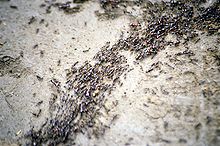Ant route
An ant route is a route that is used by many ants to e.g. B. To transport food into the building.
Marking by fragrances
Ant trails are marked by scents ( pheromones ). If an ant discovers a source of food, it makes its way back to the ant den and sprays out a trail of scent along the way. When it arrives at the ant burrow, it chokes out parts of the food and distributes it to other ants. Stimulated in this way, the other ants also set off and follow the existing scent trail. On the way home, they in turn mark the path with fragrances, so that the more ants follow it, the stronger the smell of the path. This also enables the animals to dynamically find the shortest route for them: they need more time from start to finish in a roundabout way, so that fewer scent marks can be set in the same time than on a direct connection.
This procedure is the heuristic model for the ant algorithm .
Behavior at bottlenecks
Researchers from Belgium and France have found that there is no traffic jam with ants - no matter how many ants are around. To investigate the behavior of the ants, the scientists set up two different test tracks for two different groups of ants. On the first stretch there was a wide bridge between the nest and the food source, on the other stretch the ants only had a narrow walkway on which only two ants could move past each other. The result of the investigation was that both groups managed to bring about the same amount of food into the nest in the same time.
The group of ants that had to walk over the narrow walkway showed a remarkable behavior: newly arriving insects waited together until the oncoming traffic had crossed the narrow walkway. Then the waiting group went off together, while a crowd formed on the other side. The scientists could not find any collisions during their observations.

